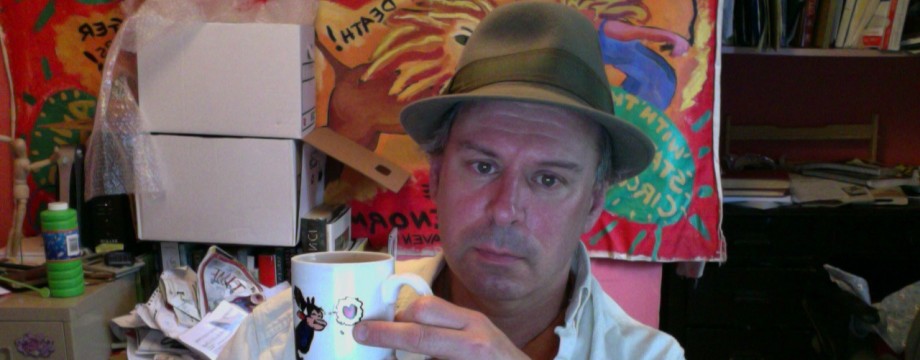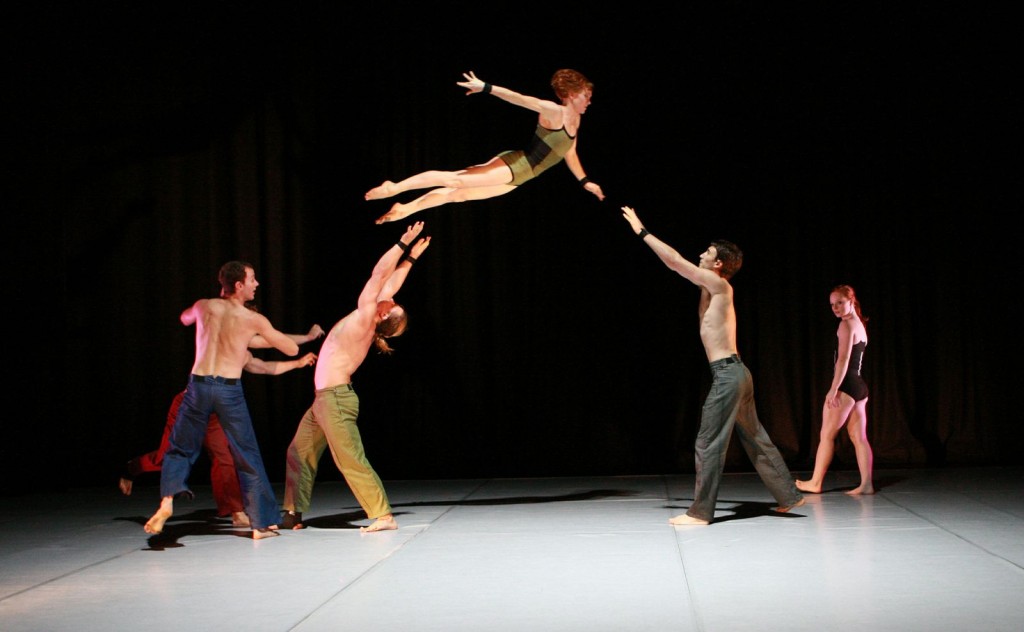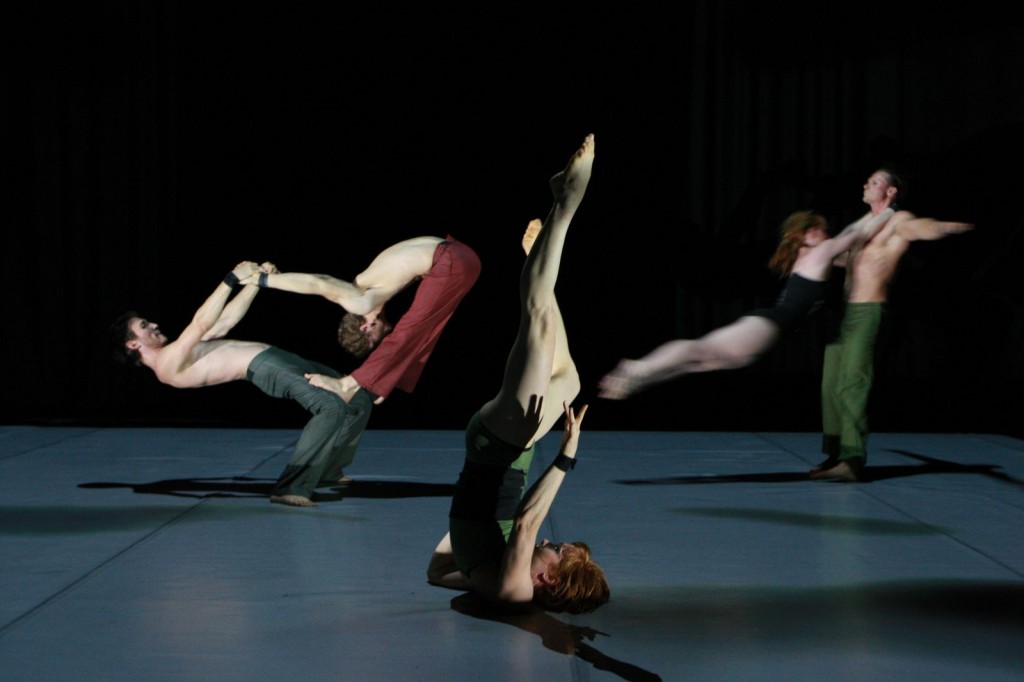Circa
Presented by the International Festival of Arts & Ideas through June 30 at the Cooperative Arts & Humanities High School, New Haven. http://artidea.org/
DirectorL Yaron Lifschitz. Associate Director: Ben Knapton. Producer: Danielle Kellie. Tour manager/director: Diane Stern. Technical Director/Lighting Designer: Jason Organ. Costume Designer: Libby McDonnell. Performers: Valerie Doucet, Casey Douglas, Freyja Edney, Darcy Grant, Scott Grove, Emma McGovern, Lewis West.
The flying upstarts of Circa, it seems, can do whatever the heck they want to. And what they want, it seems, is to chill. These acrobatic Australian theater-circus artistes so smooth and together and connected and flexible that they have no need for bombast or fanfare. They mock the very concept of spotlghts and grandstanding. They don’t even bother with little trampolines or stools or other accessories that many acrobatic acts require to get started.
This laid-back, bare-bones approach makes their act all the more astounding. Without the artifice, you’re witnessing pure breathtaking artistry.
A guy simply clambers up another guy’s back and stands on his shoulders. Then a third guy scampers up BOTH of them to create a 15-foot-plus stack of people. He leaps off, and the other two simultaneously break into leaping roles. It has the effect of a broken thermometer with the mercury rolling free. Circa then regroups for some fresh derring-do without the need to acknowledge the greatness of what they’ve just achieved. They don’t look back. They don’t look down. They climb and flip and fly and leap, but they don’t strut or preen or pose.
Their presentation is riveting in whole other ways. It’s honest and intimate and moving. In one routine, Circa gives whole new meaning to the phrase “She lets him walk all over her.” A man stands gingerly upon the backs of a woman’s legs. Soon he is standing on her thrust-out posterior. He maneuvers himself onto her shoulders, then—nowhere else to go but up—her head! Throughout his climb, the woman maintains a straightfaced, almost sullen demeanor.
In a less dominant male/female encounter which comes a little later in the variety-filled yet neatly modulated 90-minute show, a couple entwine themselves so that form a Y with their legs, the base of the letter elongated because the woman is standing on her head.
I don’t really want to be the “Been here, done that” guy again, but last week I felt obliged to point out that while the National Theatre of Scotland’s storytelling-cum-environmental-interaction model for The Strnage Undoing of Prudencia Hart (playing at the festival through June 30 in the back room of the Wicked Wolf Tavern) was indeed intimate and imaginative, but not rare in New Haven, where the Yale Cabaret does like-minded shows on a frequent basis (and in fact is doing three in repertory this summer; http://summercabaret.org/). Similarly, Circa’s mix of movement, acrobatics and physical leaps of fancy have landed in the land of Pilobolus and Momix, which have been doing such experiments for decades.
Circa compares well to those Nutmeg-based movement troupes, and certainly announces itself differently. The Circa show begins with solo turns, individualized antics and specialties, then gradually turns into duos (with undertones of dramatic relationships), then morphs into a fevered group grope, where they hurl themselves at each other with abandon. Some of this is Pilobolus-like, in the way that the performers clamber up and down each other and form bonds that register as both physical and emotional. But certain specific routines, as when a solo man conducts the crowd in finger-snapping as a brief respite from the onslaught of full-body work-outs, smack more of Stomp. In another bit, a man stretches his body, arm and neck in a manner reminiscent of the great physical clown Bill Irwin. And the throbbing pop instrumentals and mood lighting conjure up Cirque du Soleil—though it must be quickly added that Circa greatly improves on the empty grooves that pass for Cirque du Soleil soundtrack music. The Australians flip and strut to the strains of the Cake version of the old pop standard “Perhaps, Perhaps, Perhaps,” or a Jacques Brel ditty in the original feisty French, or a moody female cover (also in French) of a Radiohead song.
The Circa folk wear their influences on their sleeveless outfits, then. But those opening get-to-know-us silent solo turns aren’t false. They show that, while Circa belongs in several longstanding theater/circus traditions, they’ve found their own particular style and tone and personal identities. This is much more than an evening of stunts. It flows beautiful, builds artfully, entertains exquisitely. As an audience member, you’re not just gawking; you’re transported.
Overall, Circa lives up to its branding as a theater circus, an acrobatic display rather than a modern movement concert. It’s a muscular, spectacular display, evoking gasps and applause. So it’s particularly impressive that they’ve been able to add a patina of beauty, grace and gentle drama to the arrangement.
The troupe has several signature moves, including that aforementioned somersault-roll from a high-up upright position. They also have a tendency to shoot forward headfirst, which will remind some Arts & Ideas-goers of last week’s Mark Morris Dance Group slide-happy rendition of Vivaldi’s “Gloria.”
Circa performs these awe-striking antics without a trace of “attitude.” They don’t wink, or look smug, and do that obnoxious thing circus performers do with their hands to encourage applause. They don’t yell “Hey!” or explain to us how astounding or colossal something is before they do it. They don’t talk at all. Their preferred expressions are perplexed, vacant and deadpan. When being flung and tossed, they look bemused. When climbing a rope in high heeled shoes, or handing blocks to a colleague who’s doing a handstand on a table, so that he can handstand even higher and more precariously, they act as if these actions are the most natural in the world, and that they happen to have something else on their minds.
It’s that ho-hum demeanor, when matter-of-factly peforming mind-boggling feats, that makes Circa so distinctive and special.
You don’t need a special reason to see an act which does unimaginable things with their bodies for your amusement. But Circa offers a whole range of added incentives.
Here’s a final recommendation: Don’t be afraid of sitting in the front row, and don’t be afraid of bringing young children. I did both. One of the festival workers at the Cooperative High School site, Margaret Carl, suggested that my nearly-8-year-old daughter Sally and I sit near the stage rather than in the further-back seats that had been saved for us. It was a great idea, though the rest of the crowd (in a nearly sold-out auditorium) was shying away from that first row.
Close up, the casual air of the performers was felt even more keenly. The details of their difficult maneuvers could be more deeply appreciated. You could also see their tattoos clearly: that’s not a numeral “8” on one of the dynamic woman tumblers, it’s two interlocking “O”s. Just as Circa itself is an chain of hoop-jumping, headstrong yet intellectually intense individuals whose independent intrinsic strengths join together for a show of uncommon force and expression.
You’ll fall for Circa, even as they never fall themselves.


